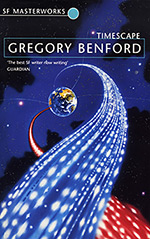
![]() charlesdee
charlesdee
6/16/2013
![]()
Benford wrote this novel in 1979 and set it in both the recent past of the early 1960's and the near future of 1998. Reading it today, we know that we are reading of a 1998 that never happened, although perhaps it never happened because of the incidents in Benford's narrative.
Earth in 1998 faces an ecological crisis that is rapidly approaching apocalyptic proportions. Pesticides used mostly in the Southern hemisphere have created diatomic blooms. Massive die-offs occur in the ocean, and their is evidence that the viruses created by the blooms have become airborne. In Cambridge, UK, scientists are working with tachyons to send messages into the past in hopes of averting the catastrophe. Tachyon are to this day theoretical particles capable of moving faster than light. In Benford's novel they are a proven reality, and his scientists target earth in the 1960's with messages warning of the coming disaster. They are received by a group in La Jolla working nuclear resonance experiments. Although this team first perceives them as noise, the patterns that emerge become unmistakable messages, sometimes hopelessly garbled and at other times explicit.
Why possibly changing the past in this way will not produce unavoidable paradoxes is explained in one of Benford's several long physics discussions that goes completely over my head. Maybe I'm old-fashioned, but it seems that if the messages were successful, earth would not be in the mess it is in 1998, and therefore they would not need to be sent. I cannot judge how effectively Benford deals with this issue. (It has something to do with a light switch stuck between on and off.) But even when the science talk gets obscure, Benford keeps his story going with believable and engaging characters. These are dedicated scientists facing not only new, paradigm-shaking concepts, but also dealing, in their respective presents, with campus politics, domestic crises, the English class system, a Jewish mother situation, a girlfriend who is voting for Goldwater, and a deteriorating social world veering from the inconvenient to the chaotic.
Benford's cast of characters includes heros, villains, and fools. In the 1960's narrative, a La Jolla professor looking into the experimental anomalies decides they are messages from an alien civilization. His irresponsible exposure of this theory almost derails the serious work being done. (At the end of the book we learn that he has since become a successful science popularizer who appears on the Tonight Show.) Ian Peterson is an upper crust British administrator sent in to keep tabs on the experiments. He is a cad, a compulsive womanizer, and in the end proves true to his class by setting up a bunker compound he foolishly thinks is a defense against the coming apocalypse.
The final chapter takes place in 1974. This leaves the main plot line open-ended, but Benford gives us a vision of time that is difficult to grasp but evocative and possibly even hopeful.
http://www.potatoweather.blogspot.com